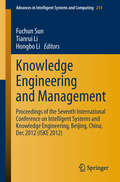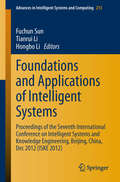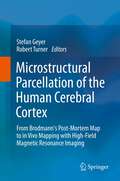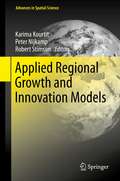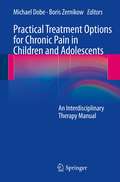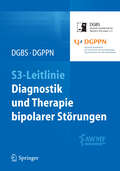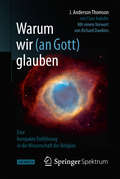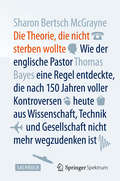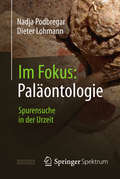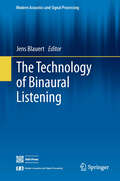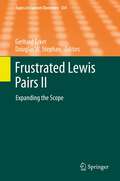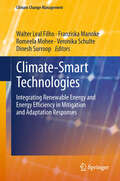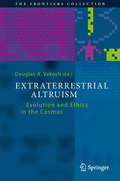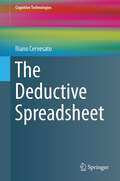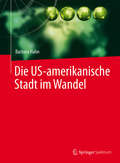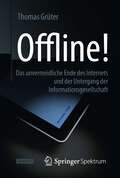- Table View
- List View
Foundations and Practical Applications of Cognitive Systems and Information Processing
by Huaping Liu Fuchun Sun Dewen Hu"Foundations and Practical Applications of Cognitive Systems and Information Processing" presents selected papers from the First International Conference on Cognitive Systems and Information Processing, held in Beijing, China on December 15-17, 2012 (CSIP2012). The aim of this conference is to bring together experts from different fields of expertise to discuss the state-of-the-art in artificial cognitive systems and advanced information processing, and to present new findings and perspectives on future development. This book introduces multidisciplinary perspectives on the subject areas of Cognitive Systems and Information Processing, including cognitive sciences and technology, autonomous vehicles, cognitive psychology, cognitive metrics, information fusion, image/video understanding, brain-computer interfaces, visual cognitive processing, neural computation, bioinformatics, etc. The book will be beneficial for both researchers and practitioners in the fields of Cognitive Science, Computer Science and Cognitive Engineering. Fuchun Sun and Huaping Liu are both professors at the Department of Computer Science & Technology, Tsinghua University, China. Dr. Dewen Hu is a professor at the College of Mechatronics and Automation, National University of Defense Technology, Changsha, China.
Knowledge Engineering and Management: Proceedings of the Seventh International Conference on Intelligent Systems and Knowledge Engineering, Beijing, China, Dec 2012 (ISKE #2012)
by Tianrui Li Hongbo Li Fuchun SunThese proceedings present technical papers selected from the 2012 International Conference on Intelligent Systems and Knowledge Engineering (ISKE 2012), held on December 15-17 in Beijing. The aim of this conference is to bring together experts from different fields of expertise to discuss the state-of-the-art in Intelligent Systems and Knowledge Engineering, and to present new findings and perspectives on future developments. The proceedings introduce current scientific and technical advances in the fields of artificial intelligence, machine learning, pattern recognition, data mining, knowledge engineering, information retrieval, information theory, knowledge-based systems, knowledge representation and reasoning, multi-agent systems, and natural-language processing, etc. Furthermore they include papers on new intelligent computing paradigms, which combine new computing methodologies, e.g., cloud computing, service computing and pervasive computing with traditional intelligent methods. By presenting new methodologies and practices, the proceedings will benefit both researchers and practitioners who want to utilize intelligent methods in their specific fields. Dr. Fuchun Sun is a professor at the Department of Computer Science & Technology, Tsinghua University, China. Dr. Tianrui Li is a professor at the School of Information Science & Technology, Southwest Jiaotong University, Chengdu, China. Dr. Hongbo Li also works at the Department of Computer Science & Technology, Tsinghua University, China.
Foundations and Applications of Intelligent Systems
by Tianrui Li Hongbo Li Fuchun SunThese proceedings present technical papers selected from the 2012 International Conference on Intelligent Systems and Knowledge Engineering (ISKE 2012), held on December 15-17 in Beijing. The aim of this conference is to bring together experts from different fields of expertise to discuss the state-of-the-art in Intelligent Systems and Knowledge Engineering, and to present new findings and perspectives on future developments. The proceedings introduce current scientific and technical advances in the fields of artificial intelligence, machine learning, pattern recognition, data mining, knowledge engineering, information retrieval, information theory, knowledge-based systems, knowledge representation and reasoning, multi-agent systems, and natural-language processing, etc. Furthermore they include papers on new intelligent computing paradigms, which combine new computing methodologies, e. g. , cloud computing, service computing and pervasive computing with traditional intelligent methods. By presenting new methodologies and practices, the proceedings will benefit both researchers and practitioners who want to utilize intelligent methods in their specific fields. Dr. Fuchun Sun is a professor at the Department of Computer Science & Technology, Tsinghua University, China. Dr. Tianrui Li is a professor at the School of Information Science & Technology, Southwest Jiaotong University, Chengdu, China. Dr. Hongbo Li also works at the Department of Computer Science & Technology, Tsinghua University, China.
Methoden in der naturwissenschaftsdidaktischen Forschung
by Dirk Krüger Ilka Parchmann Horst ScheckerDie naturwissenschaftsdidaktische Forschung greift auf ein gro#65533;es Repertoire an Forschungsmethoden f#65533;r die Gewinnung und Analyse von Daten sowie f#65533;r die Entwicklung darauf basierender Unterrichtskonzeptionen zur#65533;ck. Dieses Buch gibt einen breiten #65533;berblick und f#65533;hrt in die konkrete Anwendung verschiedener Methoden ein. Die Kapitel, geschrieben von ausgewiesenen Forscherinnen und Forschern in den Fachdidaktiken der Biologie, Chemie und Physik, greifen jeweils eine methodische Herangehensweise an naturwissenschaftsdidaktische Fragestellungen auf. Auswahl, Konstruktion, Optimierung und Einsatz der zur Fragestellung und zum Studiendesign passenden Instrumente werden erl#65533;utert und begr#65533;ndet. Ziel ist es, insbesondere dem forschenden Nachwuchs konkrete Anregungen f#65533;r ein eigenes methodisches Vorgehen hinsichtlich der Planung, Durchf#65533;hrung und Auswertung zu geben. Damit schlie#65533;t dieses Buch eine L#65533;cke in der zunehmend komplexer werdenden naturwissenschaftsdidaktischen Forschungslandschaft.
Microstructural Parcellation of the Human Cerebral Cortex: From Brodmann's Post-Mortem Map to in Vivo Mapping with High-Field Magnetic Resonance Imaging
by Robert Turner Stefan GeyerUnraveling the functional properties of structural elements in the brain is one of the fundamental goals of neuroscientific research. In the cerebral cortex this is no mean feat, since cortical areas are defined microstructurally in post-mortem brains but functionally in living brains with electrophysiological or neuroimaging techniques - and cortical areas vary in their topographical properties across individual brains. Being able to map both microstructure and function in the same brains noninvasively in vivo would represent a huge leap forward. In recent years, high-field magnetic resonance imaging (MRI) technologies with spatial resolution below 0.5 mm have set the stage for this by detecting structural differences within the human cerebral cortex, beyond the Stria of Gennari. This provides the basis for an in vivo microanatomical brain map, with the enormous potential to make direct correlations between microstructure and function in living human brains. This book starts with Brodmann's post-mortem map published in the early 20th century, moves on to the almost forgotten microstructural maps of von Economo and Koskinas and the Vogt-Vogt school, sheds some light on more recent approaches that aim at mapping cortical areas noninvasively in living human brains, and culminates with the concept of "in vivo Brodmann mapping" using high-field MRI, which was introduced in the early 21st century.
Microstructural Parcellation of the Human Cerebral Cortex: From Brodmann's Post-Mortem Map to in Vivo Mapping with High-Field Magnetic Resonance Imaging
by Stefan Geyer and Robert TurnerUnraveling the functional properties of structural elements in the brain is one of the fundamental goals of neuroscientific research. In the cerebral cortex this is no mean feat, since cortical areas are defined microstructurally in post-mortem brains but functionally in living brains with electrophysiological or neuroimaging techniques – and cortical areas vary in their topographical properties across individual brains. Being able to map both microstructure and function in the same brains noninvasively in vivo would represent a huge leap forward. In recent years, high-field magnetic resonance imaging (MRI) technologies with spatial resolution below 0.5 mm have set the stage for this by detecting structural differences within the human cerebral cortex, beyond the Stria of Gennari. This provides the basis for an in vivo microanatomical brain map, with the enormous potential to make direct correlations between microstructure and function in living human brains.This book starts with Brodmann’s post-mortem map published in the early 20th century, moves on to the almost forgotten microstructural maps of von Economo and Koskinas and the Vogt-Vogt school, sheds some light on more recent approaches that aim at mapping cortical areas noninvasively in living human brains, and culminates with the concept of “in vivo Brodmann mapping” using high-field MRI, which was introduced in the early 21st century.
Applied Regional Growth and Innovation Models (Advances in Spatial Science)
by Peter Nijkamp Karima Kourtit Robert StimsonModern spatial-economic systems exhibit a high degree of dynamics as a result of technological progress, demographic evolution or global change. In the past decade, an avalanche of new regional economic growth and innovation models has been put forward. This volume contains a unique collection of operational models of a strong applied nature that may be seen as original landmarks in the rich tradition of spatial-economic growth modelling. The contributors are recognized experts from different parts of the world.
Practical Treatment Options for Chronic Pain in Children and Adolescents: An Interdisciplinary Therapy Manual
by Michael Dobe Boris ZernikowPain is an increasingly common symptom in children and adolescents, and nearly 5% of the paediatric population now suffer from severe chronic pain conditions. This manual describes the inpatient treatment programme of one of the world's largest treatment facility for chronic pain in children - The German Paediatric Pain Centre - and the guidance provided is also applicable to outpatient pain management. Epidemiology, aetiology, diagnostics and treatment principles are all examined in detail. Criteria for inpatient treatment are explained, and the structure and organisation of a treatment centre for chronic pain are described. Therapeutic interventions are presented with the aid of many examples of pain management and health care from clinical practice. Special features of pain therapy for children and adolescents suffering from comorbid mental disorders, family difficulties or physical complaints are also discussed.
Parallel Programming: for Multicore and Cluster Systems
by Thomas Rauber Gudula RüngerInnovations in hardware architecture, like hyper-threading or multicore processors, mean that parallel computing resources are available for inexpensive desktop computers. In only a few years, many standard software products will be based on concepts of parallel programming implemented on such hardware, and the range of applications will be much broader than that of scientific computing, up to now the main application area for parallel computing. Rauber and Rünger take up these recent developments in processor architecture by giving detailed descriptions of parallel programming techniques that are necessary for developing efficient programs for multicore processors as well as for parallel cluster systems and supercomputers. Their book is structured in three main parts, covering all areas of parallel computing: the architecture of parallel systems, parallel programming models and environments, and the implementation of efficient application algorithms. The emphasis lies on parallel programming techniques needed for different architectures. For this second edition, all chapters have been carefully revised. The chapter on architecture of parallel systems has been updated considerably, with a greater emphasis on the architecture of multicore systems and adding new material on the latest developments in computer architecture. Lastly, a completely new chapter on general-purpose GPUs and the corresponding programming techniques has been added. The main goal of the book is to present parallel programming techniques that can be used in many situations for a broad range of application areas and which enable the reader to develop correct and efficient parallel programs. Many examples and exercises are provided to show how to apply the techniques. The book can be used as both a textbook for students and a reference book for professionals. The material presented has been used for courses in parallel programming at different universities for many years.
Tutorium Mathe für Biologen
by Lorenz Adlung Christian Hopp Alexandra Köthe Niko Schnellbächer Oskar StauferWarum ein Mathebuch für Biologen von Studenten für Studenten? Wir wissen, was man an Mathe für Bio wirklich für die Prüfungen und die Bachelorarbeit braucht. Wir haben selbst Bio oder Mathe/Physik studiert und hautnah erlebt, wie unglaublich beliebt Mathe für Biologen ist. Neben einer ,,natürlichen Abneigung" liegt es oft daran, dass die Lehre selten anwendungsbezogen ist. Wir haben uns bemüht, in einem Buch nur das aufzuführen, was man als Biologe wirklich benötigt und alles andere konsequent wegzulassen. Es gibt ständig Bezüge zu Publikationen aus den modernen Biowissenschaften. Solche relevanten Beispiele werden euch bestimmt hilfreich sein. Und das Beste: Das Buch ist garantiert häschenfrei! Wir rechnen nicht mit Hasenpopulationen sondern aktuellen Beispielen wie z. B. Signalwegen. Inhaltlich deckt das Buch den Stoff der ersten Mathevorlesungen für Biologen an den meisten Unis ab. Falls ihr mehr wissen möchtet, findet ihr uns auch auf Facebook unter ,,häschenfreie Mathe".
Tutorium Mathe für Biologen: Von Studenten für Studenten
by Lorenz Adlung Christian Hopp Alexandra Köthe Niko Schnellbächer Oskar StauferWarum ein Mathebuch für Biologen von Studenten für Studenten?Wir wissen, was man an Mathe für Bio wirklich für die Prüfungen und die Bachelorarbeit braucht. Wir haben selbst Bio oder Mathe/Physik studiert und hautnah erlebt, wie unglaublich beliebt Mathe für Biologen ist. Neben einer „natürlichen Abneigung“ liegt es oft daran, dass die Lehre selten anwendungsbezogen ist. Wir haben uns bemüht, in einem Buch nur das aufzuführen, was man als Biologe wirklich benötigt und alles andere konsequent wegzulassen. Es gibt ständig Bezüge zu Publikationen aus den modernen Biowissenschaften. Solche relevanten Beispiele werden euch bestimmt hilfreich sein. Und das Beste: Das Buch ist garantiert häschenfrei! Wir rechnen nicht mit Hasenpopulationen sondern aktuellen Beispielen wie z.B. Signalwegen. Inhaltlich deckt das Buch den Stoff der ersten Mathevorlesungen für Biologen an den meisten Unis ab. Falls ihr mehr wissen möchtet, findet ihr uns auch auf Facebook unter „häschenfreie Mathe“.
S3-Leitlinie - Diagnostik und Therapie bipolarer Störungen
by Michael BauerLeitlinien dienen dazu, Versorgungsfragen zu formulieren, das umfangreiche Wissen dazu zusammenzutragen und kritisch zu bewerten, gegensätzliche Standpunkte zu klären und das derzeitige Vorgehen der Wahl zu definieren. Sie sollen Patienten, Angehörige und Therapeuten bei der Entscheidung über angemessene Maßnahmen der Krankenversorgung unter spezifischen medizinischen Umständen unterstützen. Die vorliegende Leitlinie setzt dieses Ziel für die bipolaren Störungen um.
Warum wir (an Gott) glauben
by J. Anderson Thomson Clare AukoferGott ist von Menschen gemacht J. Anderson Thomson und Clare Aukofer gehen in diesem kompakten und prägnanten Werk der Frage nach, wie und warum der Geist des Menschen religiöse Überzeugungen hervorbringt. Thomson, der sich in forensischer Psychiatrie und Evolutionspsychologie einen Namen gemacht hat, untersucht die Bestandteile und Ursachen des religiösen Glaubens genauso systematisch, wie ein Wissenschaftler die Bewegungen der Himmelskörper oder die Evolution des Lebens analysiert: Für ihn sind sie ein ganz und gar natürliches Phänomen. Gemeinsam mit Clare Aukofer trägt er gewichtige Belege aus Psychologie, neurowissenschaftlicher Kognitionsforschung und verwandten Fachgebieten zusammen und legt so leicht verständlich und überzeugend dar, dass Gott (oder die Götter) von Menschen erschaffen wurden und nicht umgekehrt. Mit diesem schmalen Band empfiehlt sich Thomson gleichermaßen als lesenswerter Autor wie als führende Stimme in dem Bemühen, Vernunft und Wissenschaft den Vorrang gegenüber Religion und Aberglauben zu verschaffen.
Die Theorie, die nicht sterben wollte
by Sharon Bertsch McgrayneSuchmaschinen und Qualitätsmanagement, Versicherungen und Erdbebenvorhersagen, Verkehrsflüsse, Geheimcodes und medizinische Prognosen - die sogenannte Bayes'sche Regel ist geradezu allgegenwärtig und dennoch nur wenigen vertraut. Dabei ist sie in ihrer grundlegenden Aussage bestechend einfach: Man beginnt mit einer Vermutung und revidiert diese anhand neuer, objektiver Informationen - und gelangt so zu einer verbesserten Annahme. Für seine Anhänger ist das Bayes-Theorem eine elegante Formulierung dafür, dass man aus Erfahrung klug wird, und ein mathematisches Instrument, das einer klaren Linie folgt. Für seine Gegner ist es ein Amoklauf der Subjektivität. Sharon Bertsch McGrayne schildert in ihrem spannenden Sachbuch die erstaunliche Geschichte dieser Regel und berichtet von der Besessenheit ihrer Anhänger und Gegner. Sie beschreibt die Entdeckung des Theorems durch den britischen Geistlichen und Amateurmathematiker Thomas Bayes in den 1740er-Jahren und seine Weiterentwicklung in eine moderne Form, die fast der heutigen entspricht, durch den französischen Wissenschaftler Pierre Simon Laplace. Sie deckt auf, warum angesehene Statistiker das Theorem 150 Jahre lang mit einem Tabu belegten, während in der gleichen Zeit Praktiker darauf zurückgriffen, um Probleme zu lösen, die mit großen Unsicherheiten und einem Mangel an Informationen einhergingen. Eine wichtige Rolle spielte dabei Alan Turing, als er im Zweiten Weltkrieg den deutschen Enigma-Code knackte. Die Autorin erklärt schließlich, wie mit dem Aufkommen der immer preiswerter und für alle verfügbaren Computertechnologie in den 1980er-Jahren ein ganz neues Zeitalter für das Bayes-Theorem anbrach. Heute spielt es in Wissenschaft, Technik und Gesellschaft fast überall eine Rolle - ob es nun um die Entschlüsselung der DNA, das Börsengeschehen oder die Terrorabwehr geht.
Im Fokus: Paläontologie
by Nadja Podbregar Dieter LohmannWarum gibt es keine Mammuts mehr? Wen jagte der Tyrannosaurus rex? Und war der Neandertaler wirklich eine Sackgasse der Evolution? Um diese Fragen zu beantworten, müsste man eigentlich zurück in die Urzeit reisen können. Doch den Paläontologen gelingt es heute dank modernster Methoden auch ohne Zeitmaschine, aus fossilen Knochen, Pflanzenrelikten, aber auch Resten urzeitlicher DNA faszinierende Einblicke in die Tier- und Pflanzenwelt vergangener Epochen zu gewinnen. Dieses Buch stellt einige ihrer Erkenntnisse vor und erklärt unter anderem, warum Vögel eigentlich Dinosaurier sind, wie viel Wahrheit im Säbelzahnkater Diego aus dem Film ,,Ice Age" steckt und was unsere Gene heute noch über unsere Vorfahren verraten.
Intrinsic Immunity
by Bryan R. CullenRecent research has focused attention on the importance of intrinsic antiviral immunity, i.e. immunity mediated by factors that are constitutively expressed in many cells. In this volume, leading experts provide a comprehensive overview of this relatively new and rapidly evolving field. They cover intrinsic proteinaceous antiviral immune effectors, such as the APOBEC3 and TRIM protein families as well as Tetherin and SAMHD1, which were initially discovered by researchers studying HIV-1. Furthermore, the role of RNA interference in antiviral defense in plants and invertebrates, as well as the interplay between microRNAs and viruses in mammalian cells, are analysed. One chapter discusses how intrinsic immunity and viral countermeasures to intrinsic immune effectors drive both pathogen and host evolution, and finally the emerging evidence that DNA damage response proteins restrict infection by DNA viruses is highlighted.
The Technology of Binaural Listening
by Jens BlauertThis book reports on the application of advanced models of the human binaural hearing system in modern technology, among others, in the following areas: binaural analysis of aural scenes, binaural de-reverberation, binaural quality assessment of audio channels, loudspeakers and performance spaces, binaural perceptual coding, binaural processing in hearing aids and cochlea implants, binaural systems in robots, binaural/tactile human-machine interfaces, speech-intelligibility prediction in rooms and/or multi-speaker scenarios. An introduction to binaural modeling and an outlook to the future are provided. Further, the book features a MATLAB toolbox to enable readers to construct their own dedicated binaural models on demand.
Frustrated Lewis Pairs II: Expanding the Scope
by Gerhard Erker Douglas W. StephanFrustrated Lewis Pairs: From Dihydrogen Activation to Asymmetric Catalysis, by Dianjun Chen, Jürgen Klankermayer Coexistence of Lewis Acid and Base Functions: A Generalized View of the Frustrated Lewis Pair Concept with Novel Implications for Reactivity, by Heinz Berke, Yanfeng Jiang, Xianghua Yang, Chunfang Jiang, Subrata Chakraborty, Anne Landwehr New Organoboranes in "Frustrated Lewis Pair" Chemistry, by Zhenpin Lu, Hongyan Ye, Huadong Wang Paracyclophane Derivatives in Frustrated Lewis Pair Chemistry, by Lutz Greb, Jan Paradies Novel Al-Based FLP Systems, by Werner Uhl, Ernst-Ulrich Würthwein N-Heterocyclic Carbenes in FLP Chemistry, by Eugene L. Kolychev, Eileen Theuergarten, Matthias Tamm Carbon-Based Frustrated Lewis Pairs, by Shabana Khan, Manuel Alcarazo Selective C-H Activations Using Frustrated Lewis Pairs. Applications in Organic Synthesis, by Paul Knochel, Konstantin Karaghiosoff, Sophia Manolikakes FLP-Mediated Activations and Reductions of CO2 and CO, by Andrew E. Ashley, Dermot O'Hare Radical Frustrated Lewis Pairs, by Timothy H. Warren and Gerhard Erker Polymerization by Classical and Frustrated Lewis Pairs, by Eugene Y.-X. Chen Frustrated Lewis Pairs Beyond the Main Group: Transition Metal-Containing Systems, by D. Wass Reactions of Phosphine-Boranes and Related Frustrated Lewis Pairs with Transition Metal Complexes, by Abderrahmane Amgoune, Ghenwa Bouhadir, Didier Bourissou
Climate-Smart Technologies: Integrating Renewable Energy and Energy Efficiency in Mitigation and Adaptation Responses (Climate Change Management)
by Walter Leal Filho Romeela Mohee Dinesh Surroop Franziska Mannke Veronika SchulteThe book addresses the perceived need for a publication with looks at both, climate smart technologies and the integration of renewable energy and energy efficiency in mitigation and adaptation responses. Based on a set of papers submitted as part of the fifth on-line climate conference (CLIMATE 2012) and a major conference on renewable energy on island States held in Mauritius in 2012, the book provides a wealth of information on climate change strategies and the role of smart technologies. The book has been produced in the context of the project "Small Developing Island Renewable Energy Knowledge and Technology Transfer Network" (DIREKT), funded by the ACP Science and Technology Programme, an EU programme for cooperation between the European Union and the ACP region.
Extraterrestrial Altruism
by Douglas A. VakochExtraterrestrial Altruism examines a basic assumption of the Search for Extraterrestrial Intelligence (SETI): that extraterrestrials will be transmitting messages to us for our benefit. This question of whether extraterrestrials will be altruistic has become increasingly important in recent years as SETI scientists have begun contemplating transmissions from Earth to make contact. Technological civilizations that transmit signals for the benefit of others, but with no immediate gain for themselves, certainly seem to be altruistic. But does this make biological sense? Should we expect altruism to evolve throughout the cosmos, or is this only wishful thinking? Is it dangerous to send messages to other worlds, as Stephen Hawking has suggested, or might humankind benefit from an exchange with intelligence elsewhere in the galaxy? Would extraterrestrial societies be based on different ethical principles, or would we see commonalities with Earthly notions of morality? Extraterrestrial Altruism explores these and related questions about the motivations of civilizations beyond Earth, providing new insights that are critical for SETI. Chapters are authored by leading scholars from diverse disciplines--anthropology, astronomy, biology, chemistry, computer science, cosmology, engineering, history of science, law, philosophy, psychology, public policy, and sociology. The book is carefully edited by Douglas Vakoch, Director of Interstellar Message Composition at the SETI Institute and professor of clinical psychology at the California Institute of Integral Studies. The Foreword is by Frank Drake. This interdisciplinary book will benefit everybody trying to understand whether evolution and ethics are unique to Earth, or whether they are built into the fabric of the universe.
The Deductive Spreadsheet
by Iliano CervesatoThis book describes recent multidisciplinary research at the confluence of the fields of logic programming, database theory and human-computer interaction. The goal of this effort was to develop the basis of a deductive spreadsheet, a user productivity application that allows users without formal training in computer science to make decisions about generic data in the same simple way they currently use spreadsheets to make decisions about numerical data. The result is an elegant design supported by the most recent developments in the above disciplines. The first half of the book focuses on the deductive engine that underlies this application, the foundations that users do not see. After giving a mathematical model of traditional spreadsheet applications, we extend them with operators to perform a number of relational tasks, similar to the user view of a database but in a spreadsheet context. Expressing this extension in a logic programming framework is a natural step towards giving it powerful deductive capabilities. The second half of the book deals with the user interface, the part of the application with which the user actually interacts. We review the elements of the graphical user interface of traditional spreadsheet applications and describe practical methodologies for designing user interfaces borrowed from the field of cognitive psychology. We then propose a design that conservatively integrates mechanisms for a user to take advantage of the new deductive capabilities. This is followed by the results of some preliminary usability experiments. The book will appeal to researchers and practitioners in the various areas underlying this work. Researchers will not only find interesting new developments in their domains, but will also learn how to achieve a multidisciplinary focus. Practitioners will find fully developed solutions to numerous problems that are not easily solvable using traditional spreadsheet applications.
Abenteuer Mineralogie: Kristalle und Mineralien - Bestimmung und Entstehung
by Andreas LandmannDieses Buch führt Sie ein in die abenteuerliche Welt der Mineralien und Gesteine. In kaum einem naturwissenschaftlichen Feld können die Menschen so spannende Naturphänomene erleben wie in der Mineralogie. Die Urkräfte von Vulkanausbrüchen nehmen den Betrachter sofort gefangen. Das Funkeln von Edelsteinen, die seit Jahrmillionen im Erdinneren gewachsen sind, fasziniert Laien wie den Fachmann gleichermaßen. Alle Mineralien und Kristalle, die heute in Bergwerken und Steinbrüchen aus den Tiefen der Erde ans Tageslicht gelangen, sind älter als die gesamte Menschheitsgeschichte. Im vorliegenden Buch findet der Leser spannende Bilder von Mineralien, Edelsteinen und geologisch interessanten Orten, die der Autor als 350 Reisen besucht hat. Erlebnisse beim Mineraliensuchen geben dem Leser einen lebendigen Eindruck von Steinbrüchen und Bergwerken. Dazu wird anschaulich erklärt, wie die Kristalle zu ihren faszinierenden geometrischen Formen kommen. Für Sammler finden sich viele Mineralien- Bestimmungstipps. Mehr als 150 Bilder der wichtigsten Mineralien zeigen Ihnen die ganze Schönheit dieser Naturschätze.
Die US-amerikanische Stadt im Wandel
by Barbara HahnDie US-amerikanische Stadt ist einem steten Wandel unterworfen. Im Osten und Mittleren Westen waren die meisten Städte als Handelsstädte an Wasserwegen gegründet worden. Zu Zeiten der Industrialisierung erlebten sie einen Aufschwung, und ihr Bevölkerungsmaximum erreichten sie Mitte des 20. Jahrhunderts, als aufgrund von Suburbanisierung und Deindustrialisierung ein Bedeutungsrückgang einsetzte. Überall waren Spuren des Verfalls sichtbar, und die Prognosen für die Zukunft waren denkbar schlecht. Dieser Trend scheint gebrochen: Es geht wieder aufwärts mit der US-amerikanischen Stadt. Einem Teil der früheren Industriestädte ist ein Strukturwandel gelungen. Allerdings profitieren nicht alle Städte von dieser positiven Entwicklung, und viele schrumpfen weiter in erschreckendem Ausmaß. Gleichzeitig haben sich die Städte im Süden und Westen des Landes zu neuen Wachstumszentren entwickelt. Unabhängig von Lage und Entwicklungsstand sind in allen Städten ähnliche Prozesse wie Neoliberalisierung, Deregulierung, Privatisierung und Gentrifizierung zu beobachten. In diesem Lehrbuch werden die Charakteristika der US-amerikanischen Stadt und deren Wandel anhand aktueller Beispiele herausgearbeitet. Die Autorin: Barbara Hahn hat an der Universität Würzburg den Lehrstuhl für Wirtschaftsgeographie und hat den Wandel der US-amerikanischen Stadt seit Mitte der 1980er Jahre im Rahmen vieler Reisen und Forschungsprojekte beobachtet.
Die US-amerikanische Stadt im Wandel
by Barbara HahnDie US-amerikanische Stadt ist einem steten Wandel unterworfen. Im Osten und Mittleren Westen waren die meisten Städte als Handelsstädte an Wasserwegen gegründet worden. Zu Zeiten der Industrialisierung erlebten sie einen Aufschwung, und ihr Bevölkerungsmaximum erreichten sie Mitte des 20. Jahrhunderts, als aufgrund von Suburbanisierung und Deindustrialisierung ein Bedeutungsrückgang einsetzte. Überall waren Spuren des Verfalls sichtbar, und die Prognosen für die Zukunft waren denkbar schlecht. Dieser Trend scheint gebrochen: Es geht wieder aufwärts mit der US-amerikanischen Stadt. Einem Teil der früheren Industriestädte ist ein Strukturwandel gelungen. Allerdings profitieren nicht alle Städte von dieser positiven Entwicklung, und viele schrumpfen weiter in erschreckendem Ausmaß. Gleichzeitig haben sich die Städte im Süden und Westen des Landes zu neuen Wachstumszentren entwickelt. Unabhängig von Lage und Entwicklungsstand sind in allen Städten ähnliche Prozesse wie Neoliberalisierung, Deregulierung, Privatisierung und Gentrifizierung zu beobachten.In diesem Lehrbuch werden die Charakteristika der US-amerikanischen Stadt und deren Wandel anhand aktueller Beispiele herausgearbeitet. Die Autorin: Barbara Hahn hat an der Universität Würzburg den Lehrstuhl für Wirtschaftsgeographie und hat den Wandel der US-amerikanischen Stadt seit Mitte der 1980er Jahre im Rahmen vieler Reisen und Forschungsprojekte beobachtet.
Offline!
by Thomas GrüterNoch in diesem Jahrhundert wird die Informationsgesellschaft an ihr Ende kommen, weil die globalen Informationsnetze reißen. Das ist die provozierende These des Wissenschaftlers und Sachbuchautors Thomas Grüter Den meisten Menschen erscheint das Internet wie eine eigene Welt, in der Entfernungen keine Rolle spielen, Daten wie von selbst um den Globus fliegen und alles Wissen dauerhaft auf Knopfdruck zur Verfügung steht. Aber dieser Eindruck, so Grüter, täuscht: Das Internet ist eine von Menschen geschaffene Scheinwelt, die mit immens hohem Aufwand in Betrieb gehalten wird. Dennoch vertrauen wir dieser störanfälligen Schöpfung einige unsere wichtigsten Schätze an: nämlich unser Wissen und die Steuerung der Infrastrukturen, die uns am Leben erhalten Der Autor zeigt in seinem nachdenklich stimmenden Buch zweierlei: warum das gefährlich ist und wie wir Vorsorge treffen können, bevor es zu spät ist. In der Entwicklung der Menschheit könnte die Informationsgesellschaft durchaus einen wichtigen Meilenstein darstellen. Doch wenn wir vergessen, ihre grundlegenden Strukturen zu sichern, wird sie zusammenbrechen, bevor sie wirklich Fuß gefasst hat Grüter argumentiert schlüssig und weist nach, wie zerbrechlich die Grundlagen unserer Lebenswelt sind. Ein wichtiges und aufrüttelndes Buch zur rechten Zeit!

